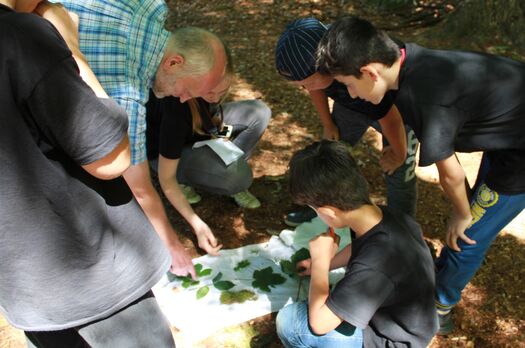48 children explore nature and the German language for two weeks

Osnabrück, July 5, 2017
The children have only 30 seconds to memorize all the objects before they disappear again under a white cloth. Then the four boys run off to collect the leaves, moss and flowers they were supposed to memorize. "Nature Memory" is the name of this station of the forest rally for the 48 children of the language summer camp at the Mentrup-Hagen school camp. At six stations, they are playfully introduced to nature, which hardly plays a role in the everyday lives of many children these days. "With this station, we want to challenge them to look closely and concentrate," explains Josef Gebbe. The employee of the Noller Schlucht learning site is responsible for the environmental education program, offered in the afternoons during the two-week summer camp. In the mornings, the third and fourth graders deal with the German language.
This year marks the ninth time that the language summer camp "Language and Nature on the Trail" has been held, this year at the Mentrup-Hagen school country home and for the first time at Haus Ossenbrock/Bissendorf. In the buildings and in the nature around them, third graders with an immigrant background improve their German language skills as if in passing, before they move on to secondary school. "There, the language level changes significantly," says Kristina Urbanovic, who is responsible for the language education concept. The employee of the Verein zur pädagogischen Arbeit mit Kindern aus Zuwandererfamilien (VPAK) (Association for Pedagogical Work with Children from Immigrant Families), together with students of teaching at the University of Osnabrück, supports the children in gaining a better command of the German language. The language courses and the nature activities are linked: each child has a treasure box for new words that he or she has learned in the forest, for example. In the language lessons, the children work with the small group to learn more about these words. For example, with the ants. "The children found it very interesting that there is an ant queen - and they asked whether there is also an ant king," says Josef Gebbe. But such an animal would be new in nature.
The summer camp was offered for the first time in 2008, and this year it is being organized by the city of Osnabrück, the district of Osnabrück, the Noller Schlucht learning site, the Verein zur pädagogischen Arbeit mit Kindern aus Zuwandererfamilien (VPAK - Association for Educational Work with Children from Immigrant Families) and the Volkshochschule Osnabrücker Land. The Friedel & Gisela Bohnenkamp Foundation has supported the summer camp since 2010. "It is an important constant in our funding activities, to which there are follow-up projects," explains Michael Prior, the managing director of the Bohnenkamp Foundation. Significant for the effectiveness of the camp, he says, is the good networking of the cooperation partners. "How well the camp is received by the families is proven by the fact that numerous children also come whose older siblings have already participated," says Prior. Around 560 children have now enjoyed the summer camp.
The girls and the boys come from 13 countries of origin. "The advertising for participation runs through the schools," explains Gabriele Grosser from the city of Osnabrück, who took over the project management this year. The teachers consider which child would benefit from participating and coordinate this with the parents. Participation in the program costs 30 euros per child - the majority of the costs are covered by the Bohnenkamp Foundation.
None of this matters to Maxim. After solving the nature memory, he first hides a leaf behind a bush. "We don't want the other groups to find it so quickly," says the boy. He enjoys being part of the summer camp. "We went to Devil's Spring, and a few days ago we made a forest sofa out of sticks," he says. That's all fun, he says. But what he enjoys most is that there is always someone there with whom he can play soccer during the breaks.